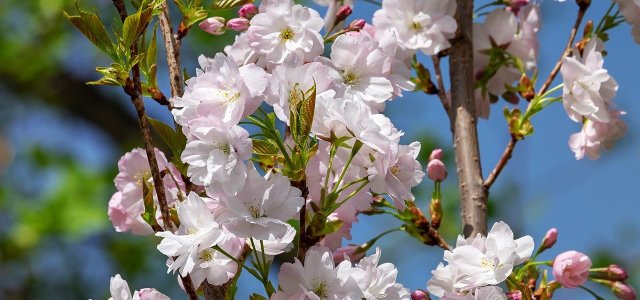
You don’t need a large garden to grow a columnar cherry, because the plant can also be planted on a balcony or terrace. What you should consider when planting and caring for this special cherry tree, you can read here.
If you don’t have too much space in your garden, or if you don’t want to do without sweet cherries even if you don’t have your own garden, a columnar cherry is the optimal solution. The fruit-bearing trees grow narrow and low and can therefore also be kept in tubs on balconies, roof gardens and terraces.
Columnar cherries and columnar fruit in general are the result of clever breeding. The trees grow to a maximum height of two to three meters, but beyond that they are quite normal cherry trees.
Tip: If you want to get yourself a single columnar cherry, you should go for a self-pollinating variety. These do not require another tree for pollination. Example varieties include Campanilo, Claudia, Sara, Stella and Victoria.
Contents
Columnar cherry: the optimal location
As far as its location is concerned, the columnar cherry has the same preferences as conventional cherry trees. In the best case you will find a full-sun location – the more sun the tree gets, the sweeter and tastier the fruits will be. The best place is protected from the wind and little danger of frost.
The soil should be loose, humus and moist. Wet, heavy soils do not tolerate columnar cherries. The plants also prefer medium-heavy, slightly acidic to slightly alkaline soil.
Planting a columnar cherry: this is how it works
Once you have found a suitable location for your columnar cherry, you can plant it. The best way to do this is as follows:
- Dig a planting hole that is about twice as deep and wide as the diameter of the plant’s root ball. Tip: If you want to plant your columnar cherry in a tub, it should have at least 30 to 40 liters of filling capacity.
- If your soil is very poor in nutrients, you can mix in some humus or compost before planting the plant. By the way: If you don’t know what your soil is like, you can take a soil sample and have it analyzed.
- Place the plant in the hole. The root ball should be flush with the soil. So the plant should not be planted deeper or higher than the soil.
- Fill the hole with soil and tamp it down with your feet.
- Water the plant generously.
Tip: If you want to plant several columnar cherries, you should keep a distance between them of at least 80 centimeters, better one meter.
It is also advisable to use a support rod. Before placing the plant in the hole, you can bury it about 30 centimeters deep. Then tie the columnar cherry to it with a rope.
Correct care of the columnar cherry
Pillar cherries are quite easy to handle and do not require much care. Just stick to the following tips and you should be rewarded with a bountiful harvest:
- In the summer and when it’s dry, columnar cherries need plenty of water. Water it regularly and generously. Avoid waterlogging at all costs.
- In spring, as soon as the first shoots appear, you can provide the plant with some compost to supply it with nutrients. Finally, you should fertilize in August, so that the new shoots can still sprout until frost.
- In winter, you can protect columnar cherries in containers from frost with fleece, jute or coconut mats. In addition, place the pot on a piece of wood so that not too much cold comes from below.
- If you cultivate the plant in a pot, you should repot it every two to three years.
Pruning columnar cherry: Tips and tricks
Basically, sweet cherries, to which the columnar cherries also belong, often sprout strongly and are very fond of growth. Therefore, you should prune them annually after harvest.
Remove all weak and diseased shoots as well as very old and very woody shoots.
All side shoots should be cut back to two to three eyes. Eye is a synonym for bud – you can recognize eyes by the thickening of the shoots on which the tree sprouts. The side shoots should remain about 20 to 30 centimeters long.
If some shoots grow very densely or cross each other, you can also thin them out.

